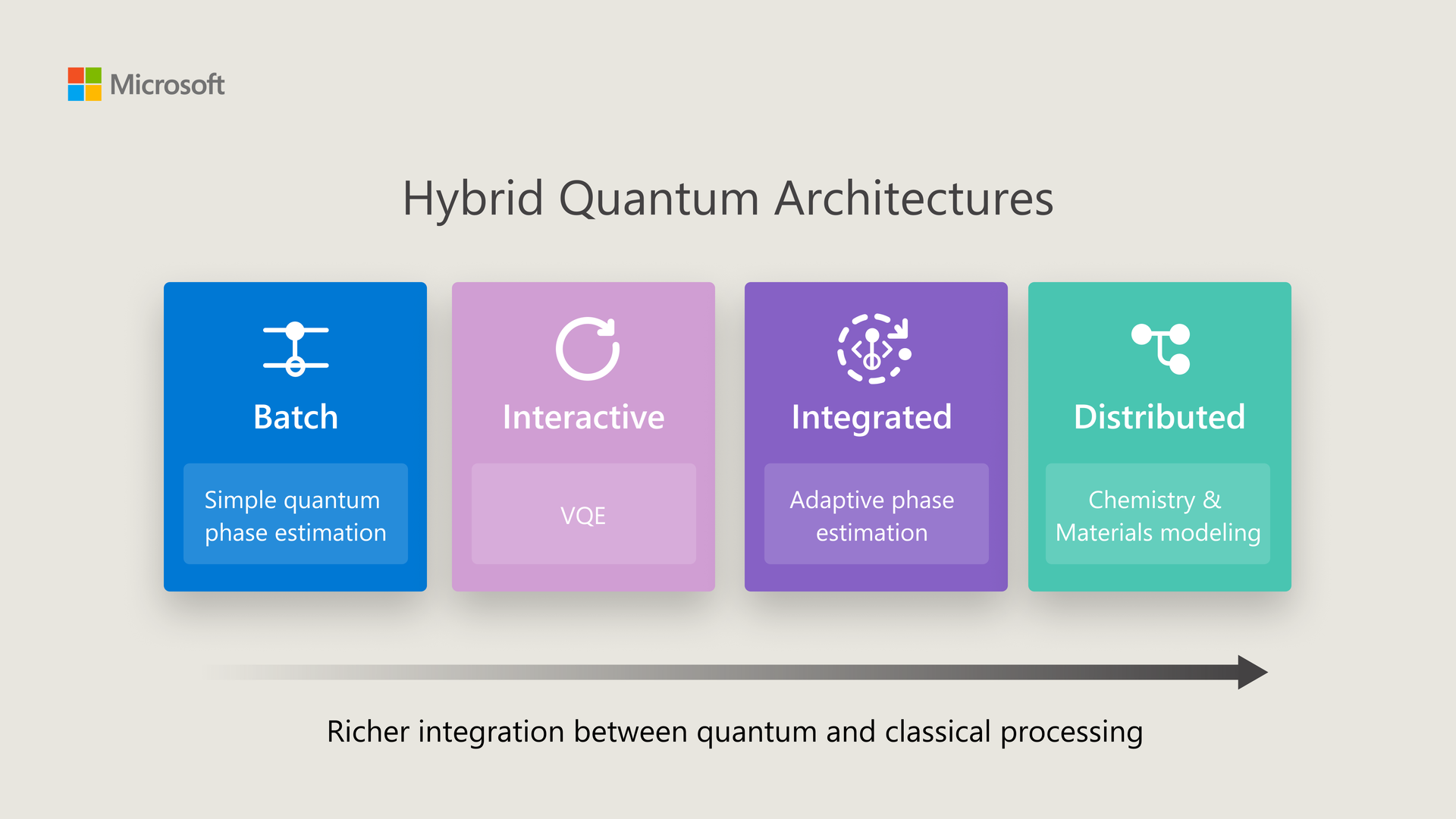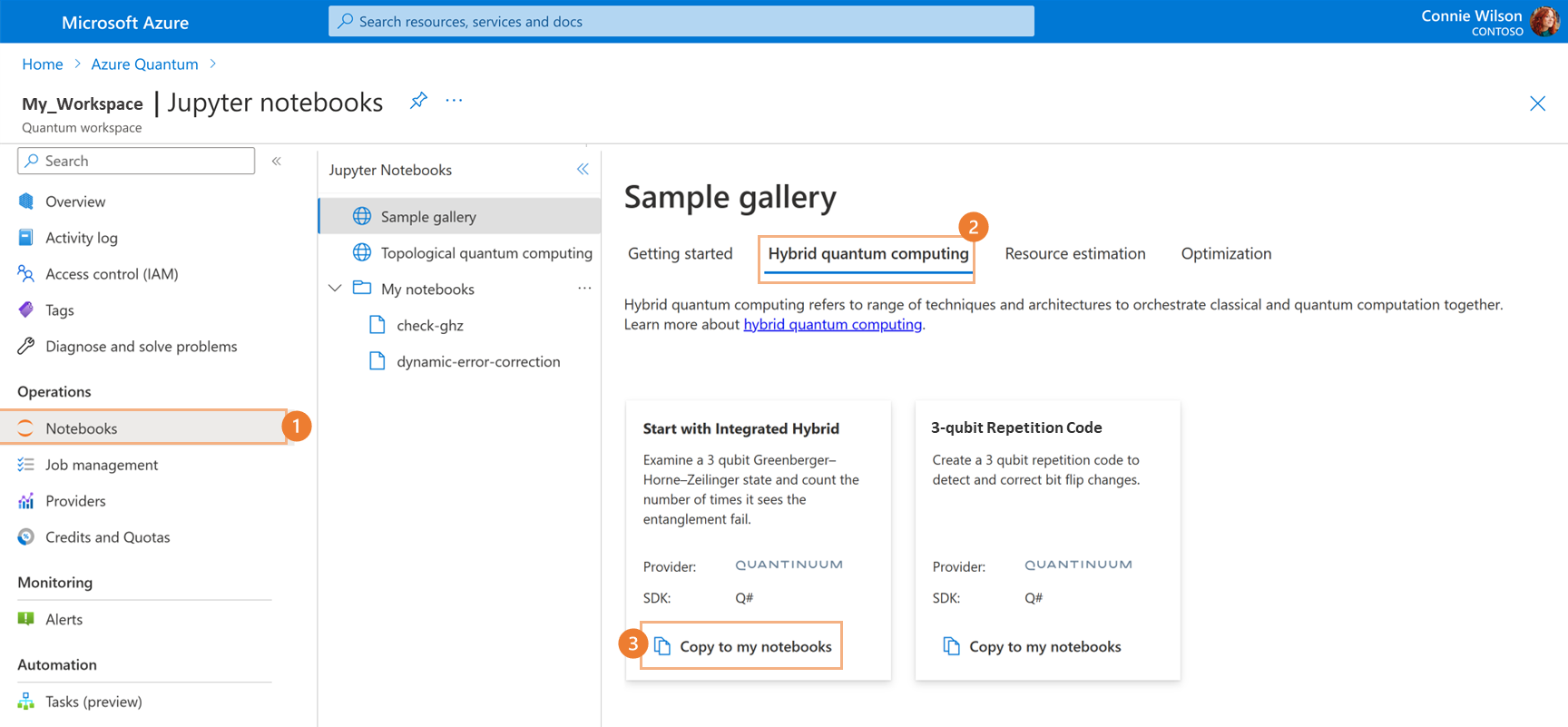Today, Microsoft announced a significant quantum advancement and made our new Integrated Hybrid feature in Azure Quantum available to the public.
Quantum computing is inherently hybrid. The key to unlocking impactful, commercial applications at scale will be deep integration between classical computing capabilities including HPC and AI with scaled quantum computing in the cloud.
Now, researchers can begin developing hybrid quantum applications with a mix of classical and quantum code together that run on one of today’s quantum machines, the Quantinuum H-Series in Azure Quantum. This capability unlocks a new generation of hybrid algorithms and is a first for the industry.
The new Integrated Hybrid feature is an important step forward and is a key part of our Hybrid Quantum Computing Architectures. As you can see in Figure 1, tighter and richer integrations will be made available between quantum and classical computing as each milestone is reached on the path to scaled quantum computing.
 Figure 1 – Hybrid Quantum Computing Architectures
Figure 1 – Hybrid Quantum Computing Architectures
This launch introduces integrated quantum computing, enabling scientists to devise new algorithms such as adaptive phase estimation that can iterate and adapt over classical computation while physical qubits are coherent, as illustrated in Figure 2.
“Quantum computing hardware is rapidly improving. Enabling solutions such as the integrated hybrid tools from Azure Quantum empower users to take advantage of the emerging hardware features and capabilities”, Tony Uttley, President & Chief Operating Officer at Quantinuum
This new capability also represents a milestone for students engaging with quantum computing. Students can begin to learn algorithms without drawing circuits, and can instead leverage high level programming constructs such as branching based on qubits measurements (if statements), loops (for…), calculations and function calls.
 Figure 2: Example of an Integrated Hybrid program
Figure 2: Example of an Integrated Hybrid program
“The ability to do high fidelity iterative circuits, including classical calculations within runtime, opens up a whole new set of algorithms. Each algorithm could significantly improve fidelities just like iterative phase estimation, and bring us closer to Quantum Advantage.”, shares Michael Egan, Director Quantum Technologies at KPMG.
A new generation of hybrid algorithms
Early adopters of integrated hybrid capabilities have already developed or adapted new algorithms applicable to a broad range of fields including chemistry, machine learning, and error correction:
“Error correction methods described in research papers and reserved to quantum hardware manufacturers can now be implemented and tested by scientists around the world. Using Azure Quantum and QCI unique real-time capabilities, the Entropica Labs team implemented a simple process for the quantum repetition code scheme. The data allowed the team to investigate the effects of noise on different initial quantum states, and different circuit variations of the scheme. It also allowed the team to test the effectiveness of different error-correction recovery strategies. This opens the possibility of optimizing code schemes for better efficiencies, based on real-world hardware environments. Azure Quantum provides the framework to ensure that in the quest of achieving scalability, error-correction code schemes can tested and optimized at each step of the way” explains Jing Hao Chai, Fault-tolerant Quantum Computing Scientist at Entropica Labs.
“Azure Quantum, equipped with a new quantum computer hybrid architecture, has become a powerful platform that allows us for a wide range of research possibilities.” tells Tennin Yan, CEO at QunaSys.
A collaborative effort across industry leaders
Developing hybrid quantum computing architectures requires a full stack approach – software and hardware are married to deliver new capabilities and the highest possible performance. The QIR Alliance, created in September 2022 and composed of leading quantum software and hardware vendors, has driven innovation into integrated hybrid capabilities via the Quantum Intermediate Representation.
“We are proud to see that the efforts of the QIR Alliance have resulted in achieving a tighter integration between quantum and classical resources. These recent advances are a critical step towards a practical use of quantum acceleration. We are excited about the new opportunities for application research that are now available to everyone.”, Dr Bettina Heim, Chair of the QIR Alliance.
“QIR is the main enabler for increasing expressivity of quantum programs in a standard and interoperable manner. Using hardware-specific QIR profiles, end users can take full advantage of the unique capabilities provided by the H-Series quantum computers including runtime support for measurement-conditioned program flow control – a key building block of quantum error correction paving the way towards fault tolerant quantum computing of the future.” said Alex Chernoguzov, Chief Engineer of Commercial Products at Quantinuum
Start exploring Integrated quantum computing
You can try integrated hybrid quantum computing on Azure Quantum for free. All users are eligible for $500 in Azure Quantum credits – use it to explore and experiment with any Quantinuum QPU available on the platform. You can also apply for up to $10,000 in research credits on Azure Quantum to further your quantum research and innovation. To get started, just set up an Azure account (check out free Azure accounts for students), create an Azure Quantum workspace in the Azure Portal, and start your quantum journey with Azure Quantum.
For an installation free experience, try our hosted notebooks experience in the Azure Portal. Hosted notebooks enable a variety of languages and Quantum SDKs. To try hosted notebooks:
- Select Jupyter notebooks > Sample gallery
- Clone a hybrid quantum computing sample.
- Run your first integrated hybrid sample by clicking on the Run all button at the top of the notebook.

Executing this sample will help you learn how to develop algorithms performing iterative and adaptive calculations while qubits are coherent, mixing classical and quantum compute operations. Programming against specialized high-performance hardware running next to the QPU, such as FPGAs, is no longer required. Running an equivalent program without integrated hybrid capabilities would require returning every intermediate measurement result and then running post processing on the data.
Using Python + Q#
This sample verifies a 3 qubit Greenberger–Horne–Zeilinger (GHZ) state and counts up the number of times it sees the entanglement fail out of 10 attempts. Without noise, this would return 0 for every shot, but with noise you can get back failures.
| import qsharp.azure
# Enter your Azure Quantum workspace details here
qsharp.azure.connect(resourceId=”, location=”)
%%qsharp
open Microsoft.Quantum.Measurement;
open Microsoft.Quantum.Arrays;
open Microsoft.Quantum.Convert;
operation CheckGHZ() : Int {
use q = Qubit[3];
mutable mismatch = 0;
for _ in 1..10 {
H(q[0]);
CNOT(q[0], q[1]);
CNOT(q[1], q[2]);
// Measures and resets the 3 qubits
let (r0, r1, r2) = (MResetZ(q[0]), MResetZ(q[1]), MResetZ(q[2]));
// Adjusts classical code based on measurement results
if not (r0 == r1 and r1 == r2) {
set mismatch += 1;
}
}
return mismatch;
}
# Set a Quantinuum target back-end with Adaptive Execution flag, and submit job
qsharp.azure.target(‘quantinuum.sim.h1-1e’)
qsharp.azure.target_capability(‘AdaptiveExecution’)
# This run will use approximatively 10 HQCs (Quantinuum billing unit)
result = qsharp.azure.execute(CheckGHZ, shots=50, jobName=’Check GHZ’, timeout=240)
result
|
Learn More
At Microsoft, we are architecting a public cloud with Azure that enables scaled quantum computing to become a reality and then seamlessly delivers the profound benefits of it to our customers. In essence, artificial intelligence, high-performance computing and quantum are being co-designed as part of Azure and the integration of which will have an impact in important ways in the future.
Learn more about how Microsoft is harnessing the power of the cloud to make the promise of quantum at scale a reality and join our upcoming Microsoft Quantum Innovation Series with Mark Russinovich, Chief Technology Officer and Technical Fellow of Azure at Microsoft and Krysta Svore, Distinguished Engineer and Vice President of Advanced Quantum Development, Quantum at Microsoft.
Also, to learn more about how to use the new Integrated Hybrid feature in Azure Quantum, register for the Developer Webinar and read the full documentation.
#quantumcomputing #quantumcloud #azurequantum #quantinuum #QIR


Azure Quantum represents a significant milestone in the development of quantum computing, unlocking the next generation of hybrid quantum computing. Thanks for your hard work and dedication in bringing this innovative technology to market, and I look forward to seeing the groundbreaking applications that will emerge from this platform.
Mobile & Web